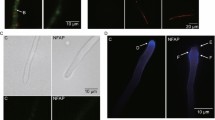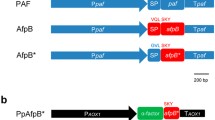Abstract
The filamentous fungus Penicillium chrysogenum abundantly secretes the small, highly basic and cysteine-rich protein PAF (Penicillium antifungal protein). In this study, the antifungal activity of PAF is described. PAF inhibited the growth of a variety of filamentous fungi, including opportunistic human pathogenic and phytopathogenic fungi, whereas bacterial and yeast cells were unaffected. PAF reduced the conidial germination and hyphal extension rates in a dose-dependent manner and induced severe changes in cell morphology that resulted in crippled and distorted hyphae and atypical branching. Growth-affected hyphae suffered from oxidative stress, plasma membrane leakage, and metabolic inactivity, which points to an induction of multifactorial effects in sensitive fungi. In contrast to other known antifungal proteins, the effects of PAF were only partially antagonized by cations.





Similar content being viewed by others
References
Abad LR, D'Urzo, MP, Narasimhan, ML, Reuveni, M., Zhu, JK, Niu, X., Singh, NK, Haegawa, PM, Bressan, RA (1996) Antifungal activity of tobacco osmotin has specificity and inolves plasma membrane permeabilization. Plant Sci 118:11–23
Bormann C, Baier D, Horr I, Raps C. Berger J, Jung G, Schwarz H (1999) Characterization of a novel, antifungal, chitin-binding protein from Streptomyces tendae Tu901 that interferes with growth polarity. J Bacteriol 181:7421–7429
Broekaert WF, Terras, FRG, Cammue, BPA, Vanderleyden J. (1990) An automated quantitative assay for fungal growth inhibition. FEMS Microbiol Lett 69:55–59
De Samblanx GW, Goderis IJ, Thevissen K, Raemaekers R, Fant F, Borremans F, Acland DP, Osborn RW, Patel S, Broekaert W (1997) Mutational analysis of a plant defensin from radish (Raphanus sativus L.) reveals two adjacent sites important for antifungal activity. J Biol Chem 272:1171–1179
Dimarcq JL, Bulet P, Hetru C, Hoffmann J (1998) Cysteine-rich antimicrobial peptides in invertebrates. Biopolymers 47:465–477
Ezaki B, Gardner RC, Ezaki Y, Matsumoto H (2000) Expression of aluminium-induced genes in transgenic Arabidopsis plants can ameliorate aluminium stress and/or oxidative stress. Plant Physiol 122:657–665
Ganz T (1994) Biosynthesis of defensins and other antimicrobial peptides. Ciba Found Symp 186:62–71
Garcia-Olmedo F, Molina A, Alamillo JM, Rodriguez-Palenzuela P (1998) Plant defense peptides. Biopolymers 47:479–491
Geisen R (2000) P. nalgiovense carries a gene which is homologous to the paf gene of P. chrysogenum which codes for an antifungal peptide. Int J Food Microbiol 62:95–101
Lass-Florl C, Nagl M, Speth C, Ulmer H, Dierich MP, Wurzner R (2001) Studies of in vitro activities of voriconazole and itraconazole against Aspergillus hyphae using viability staining. Antimicrob Agents Chemother 45:124–128
Lee GD, Shin SY, Maeng CY, Jin ZZ, Kim KL, Hahm KS (1999) Isolation and characterization of a novel antifungal peptide from Aspergillus niger. Biochem Biophys Res Commun 263:646–651
Levina NN, Lew RR, Hyde J, Heath IB (1995) The role of Ca2+ and plasma membrane ion channels in hyphal tip growth of Neurospora crassa. J Cell Sci 108:3405–3417
Ludwig A, Boller T (1990) A method for the study of fungal growth inhibition by plant proteins. FEMS Microbiol Lett 69:61–66
Martinez Del Pozo A, Lacadena V, Mancheno JM, Olmo N, Onaderra M, Gavilanes JG (2002) The antifungal protein AFP of Aspergillus giganteus is an OB fold-containing protein that produces condensation of DNA. J Biol Chem 277:46179–46183
Marx F, Haas H, Reindl M, Stoffler G, Lottspeich F, Redl B (1995) Cloning, structural organization and regulation of expression of the Penicillium chrysogenum paf gene encoding an abundantly secreted protein with antifungal activity. Gene 167:167–171
Millard PJ, Roth BL, Thi HP, Yue ST, Haugland RP (1997) Development of the FUN-1 family of fluorescent probes for vacuole labeling and viability testing of yeasts. Appl Environ Microbiol 63:2897–2905
Moore CB, Sayers N, Mosquera J, Slaven J, Denning DW (2000) Antifungal drug resistance in Aspergillus. J Infection 41:203–220
Osborn RW, De Samblanx GW, Thevissen K, Goderis I, Torrekens S, Van Leuven F. Attenborough S, Rees SB, Broekaert WF (1995) Isolation and characterisation of plant defensins from seeds of Asteraceae, Fabaceae, Hippocastanaceae and Saxifragaceae. FEBS Lett 368:257–262
Raj PA, Dentino AR (2002) Current status of defensins and their role in innate and adaptive immunity. FEMS Microbiol Lett 206:9–18
Roos W, Schulze R, Steighart J (1997) Dynamic compartmentation of vacuolar amino acids in Penicillium cyclopium. J Biol Chem 272:15849–15855
Slayman CL, Slayman CW (1968) Net uptake of potassium in Neurospora. Exchange for sodium and hydrogen ions. J Gen Physiol 52:424–443
Tao J, Ginsberg I, Banerjee N, Held W, Koltin Y, Bruenn JA (1990) Ustilago maydis KP6 killer toxin: structure, expression in Saccharomyces cerevisiae, and relationship to other cellular toxins. Mol Cell Biol 10:1373–1381
Terras FR, Schoofs HME, De Bolle MFC, Van Leuven F, Rees SB, Vanderleyden J, Cammue BPA, Broekaert WF (1992) Analysis of two novel classes of plant antifungal proteins from radish (Raphanus sativus L.) seeds. J Biol Chem 267:15301–15309
Terras FR, Torrekens S, Van Leuven F, Osborn RW, Vanderleyden J, Cammue BP, Broekaert WF (1993) A new family of basic cysteine-rich plant antifungal proteins from Brassicaceae species. FEBS Lett 316:233–240
Theis T, Wedde M, Meyer V, Stahl U (2003) The antifungal protein from Aspergillus giganteus causes membrane permeabilization. Antimicrob Agents Chemother 47:588–593
Thevissen K, Ghazi A, De Samblanx GW, Brownlee C, Osborn RW, Broekaert WF (1996) Fungal membrane responses induced by plant defensins and thionins. J Biol Chem 271:15018–15025
Thevissen K, Osborn RW, Acland DP, Broekaert WF (1997) Specific, high affinity binding sites for an antifungal plant defensin on Neurospora crassa hyphae and microsomal membranes. J Biol Chem 272:32176–32181
Thevissen K, Terras FR, Broekaert WF (1999) Permeabilization of fungal membranes by plant defensins inhibits fungal growth. Appl Environ Microbiol 65:5451–5458
Tossi A, Sandri L, Giangaspero A (2000) Amphipathic, alpha-helical antimicrobial peptides. Biopolymers 55:4–30
Wnendt S, Ulbrich N, Stahl U (1994) Molecular cloning, sequence analysis and expression of the gene encoding an antifungal-protein from Aspergillus giganteus. Curr Genet 25:519–523
Acknowledgements
We thank Martin Kirchmair and Reinhard Würzner for providing fungal strains, and Hubertus Haas and Bernhard Redl for helpful discussions. This work was funded by the Austria Science Foundation (grant FWF P15261 to F. M.).
Author information
Authors and Affiliations
Corresponding author
Rights and permissions
About this article
Cite this article
Kaiserer, L., Oberparleiter, C., Weiler-Görz, R. et al. Characterization of the Penicillium chrysogenum antifungal protein PAF. Arch Microbiol 180, 204–210 (2003). https://doi.org/10.1007/s00203-003-0578-8
Received:
Revised:
Accepted:
Published:
Issue Date:
DOI: https://doi.org/10.1007/s00203-003-0578-8




